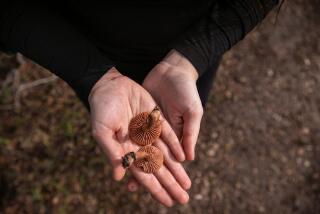Far East Traditions Sprout in Southland
- Share via
RIMFOREST, Calif. — When it comes to the culinary delights of the Western world, the bracken fern, a common forest plant known to poison livestock and linked to cancer in animals, doesn’t rank up there with caviar and champagne.
Unlike the widely eaten wood and ostrich ferns, the bracken is mainly known as a forest weed.
“As far as food in the Western world is concerned, I know of no one who eats it, except by mistake,” said N.J. Secord, president of Northwood Farms of New Brunswick, Canada, a major supplier of edible ferns.
But the Koreans and Japanese consider the bracken fern a delicacy, and its sprouting each spring brings heavy traffic to what has become the center of the American bracken fern harvest--the San Bernardino National Forest.
Sprouting Everywhere
“It’s amazing,” said fern picker Young Kim as he looked at spindly, pale-green ferns that seemed to sprout everywhere along California 18 near here. “We all wonder why Americans don’t eat it.”
From May to June, when the young plant is safe to eat in limited quantities, thousands of Koreans and Japanese from Southern California swarm through the forest with giant plastic bags in search of the bracken fern.
Chartered buses carrying pickers from Los Angeles rush along the mountain roads; church groups sponsor regular picking and picnicking excursions.
The harvest has become so popular that some say even friends in the Far East have heard of the forest’s abundant supply of the plant.
‘Remember the Old Times’
While preserved bracken fern can be easily bought in Koreatown or Little Tokyo, many say that picking the plant has become more than just a harvest, but a chance to remember a homeland thousands of miles away.
“For just a fraction of a second you remember the old times,” said 60-year-old H.O. Kim of Studio City, who rested beneath a tree after recently picking ferns in the forest for the first time since he was a child in Korea. “It’s a very good memory.”
The bracken fern, or Pteridium aquilinum, is found in wet lowlands and forest areas throughout the world, said Andrew Sanders, museum scientist at the UC Riverside Herbarium.
It is, in fact, the most common fern in the mountains of California and will grow just about anywhere if it has enough water, Sanders said.
But the harvest in the San Bernardino National Forest has taken on proportions unmatched elsewhere in the United States.
2,849 Permits Issued
It is the only national forest where permits are required to harvest the fern and where pickers are restricted to selected areas. Last year, the U.S. Forest Service issued permits to 2,849 people who picked 24,500 pounds of fern over about five weekends.
Mark Chislock-Bethke, a resource forester with the U.S. Forest Service, said the fern is abundant and easily accessible in the San Bernardino National Forest.
The forest is also close to Los Angeles, with its large Korean and Japanese populations.
“It’s just wonderful for them,” he said. “It’s a recreational experience for the whole family.”
No one knows for certain how long people have been picking the fern in the San Bernardino Mountains, but Chislock-Bethke said the Forest Service began issuing permits seven years ago, after complaints of trespassing, littering and traffic.
Fewer Complaints
Since the Forest Service began the permit process, complaints have dwindled and many residents say they have grown accustomed to the crowds.
“Live and let live,” said Clayton Rayburn, who lives next to one of the most popular picking areas in the Valley of Enchantment. “I’ve heard an awful lot of shouting and threats, but it has been no big deal for me.”
The fern pickers harvest only the top few inches of the plant before it sprouts fronds and becomes toxic. The young fern is later boiled or dried.
The harvesting of the fern can seem strange to many in the United States and elsewhere who mainly see the fern as a “pest, a real nuisance,” Chislock-Bethke said.
Foresters curse the plant because it spreads so quickly, shutting out other plants and preventing seedlings from taking root, Chislock-Bethke said. Sanders said farmers detest it because it can poison farm animals that eat the plant’s fronds.
Health Hazards
Studies have also linked the fern to stomach cancer in livestock that each large quantities of the plant.
To make matters more discouraging, according to Korean folklore, the bracken fern undermines sexual stamina if eaten in excessive quantities.
“Buddhist monks eat a lot of it,” Kim said. “It’s good for them, but not for other males.”
But none of these problems seem to have deterred avid fern eaters.
“If it causes cancer, it’s no matter,” said Chong Cha Haena, who made the 1 1/2-hour drive from Gardena with members of her church. “It’s like smoking. If you die, you die.”
The fern has a long culinary history.
The Maoris of New Zealand eat it as a vegetable, American hikers eat it raw in emergencies, and the Norwegians have even made beer out of it.
But its greatest popularity is in the Far East, where it is both scarce and expensive.
In Korea, the fern is called kosari and is a prime ingredient in bibimbab, a well-known dish of rice, mixed vegetables and beef.
Ceremonial Uses
It is also eaten to celebrate New Year’s Day and offered at the graves of ancestors during ceremonies in the spring.
Haena said the fern sprouts are usually boiled and then dried so they can be eaten throughout the year.
After soaking in water, the fern looks like thick, brown spinach stems and takes on a taste and texture that some compare to asparagus.
The Japanese call bracken fern warabi and stir-fry it with meat or serve it with miso soup or in sansai udon, a noodle dish.
Kimiko Tokonaga, who was accompanying her mother on a trip to gather warabi, said her family usually boils it and then stores it with salt in a jar left in the garage.
For the last two years, her mother, Haruyo, has come to pick the fern. She recently wandered the mountainside with a scarf over her head and a plastic visor shielding her eyes from the sun, grabbing every warabi in her path.
“She visits here every May,” Tokonaga said.
Tokonaga said one of the most important things for her mother are the memories that are rekindled when she picks the fern.
“Inside her mind she has her memory of picking the fern with her own mother years ago,” said Tokonaga, as she watched her mother move from stem to stem, plucking off the top five or six inches of the fern.
Tokonaga said she personally thinks the fern tastes like “nothing.” But she added: “I’m happy, because my mother is happy.”







